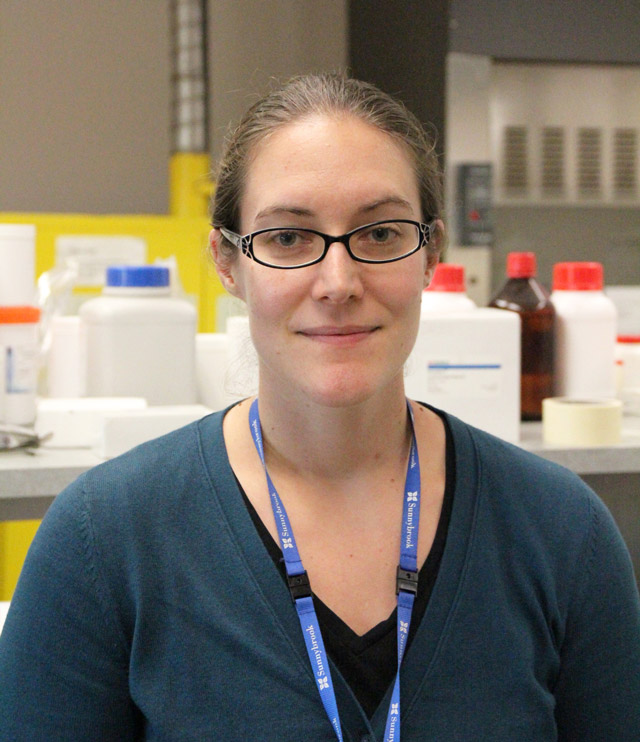CV: Dr. Colleen Bailey
Bio basics: A scientist in Physical Sciences and the Odette Cancer Research Program at Sunnybrook Research Institute (SRI). Completed her undergraduate degree at the University of Guelph, PhD at the University of Toronto and a postdoctoral fellowship at University College London in London, U.K. Born in Trenton, Ont. Joined SRI in July 2017, and has lived in Toronto since then.
What is your research focus?
I look at MRI methods to monitor cancer therapy. At the Odette Cancer Centre they have a lot of new developments in radiation therapy, and I’m trying to come up with ways we can monitor patients to predict who’s responding to therapy and who’s not. Then we can adjust treatment based on what we see, hopefully.
You were here as a student from 2006 to 2012. What’s it like being here now as an appointed scientist?
It’s good. It’s interesting because I still know quite a few people, but there are new faces, too. Now, I’m more on the management side, so trying to deal with grants and things like that, and getting my own program organized. PhD programs are good here because they’re pretty independent, but this is on another level.
What are your impressions of SRI now that you’re no longer a student?
I came from London, U.K., where it’s crowded and they have a ton of people working on everything. Where I was, at least, there weren’t so many resources. Here, it’s nice because it’s a research hospital and there are all kinds of resources for imaging and people who work on different imaging techniques, which is quite different from where I was in London. That’s been one of the nice things about returning.
Do you miss London?
Sometimes. I think it was my limit in terms of big cities. I think I’m a bit more comfortable in Toronto.
Why did you choose to study cancer treatment?
There’s just so much to do. I guess you can say that about a lot of diseases, though. I actually started my PhD on a stroke project, but then a scientist here, Dr. Greg Czarnota, was trying to measure cell death with ultrasound, and I guess he thought, ‘Let’s see what we can do with MRI.’ I did some measurements for him, and then that led into my whole PhD project. There’s so much you can look at with cancer treatment.
What would you say some of the biggest challenges are in your field?
Where to begin? [laughs] One thing with MRI is that it’s quite sensitive to a lot of things that change, so a lot of the time when you start out with a method, you think, ‘Oh, I see something that’s changing.’ As it turns out, though, a lot of things can cause that change. A lot of the work we do is to try to make things more specific and ask, ‘How can we differentiate when something is changing because the cancer is progressing versus when it’s changing because there’s inflammation?’ It’s about specificity.
What are you working on at the moment?
We just started this, so it’s quite early, but we had a collaborator come in November from Sweden, Dr. Filip Szczepankiewicz, who has a new sequence on the MRI scanner. MRI scanners come with standard sequences, but you can write your own to try to do different things. He’s helping us set up this sequence that’s intended to look at diffusion MRI at a much smaller scale than the standard sequence does it. We’re hoping to see microscopic changes that you can’t see with the standard sequence.
Did you always want to become a scientist, even as a kid?
No, not always, but probably from high school on. At one point I wanted to be a chef, which is sort of sciencey, in a way. I also thought about going into accounting. When I was really young I wanted to be a ballerina. [laughs]
How do you like to unwind?
I play Frisbee. Actually, that started with a team I was on at Sunnybrook. I also like to knit.
What talent would you acquire if you could snap your fingers and immediately gain it?
To be a little bit more outspoken.
You’re offered an all-expenses-paid vacation to any destination in the world. Where do you go and why?
I’d probably go back to London to visit friends. It’s a really nice place to visit, in spite of the weather. [laughs] I traveled around a fair bit in the U.K. I didn’t get over to continental Europe as much as I wanted to, although I got a few chances because I was on some big E.U. projects, so I’d like to do more of that.
You’re shipped to a desert island and you can bring only one movie and one album. What do you bring?
I would probably bring The Princess Bride [laughs] and The Hard and the Easy, by Great Big Sea.



